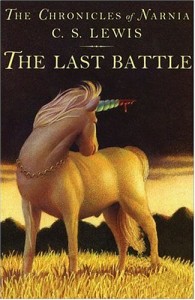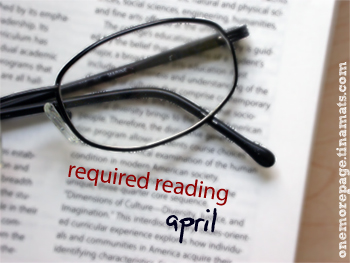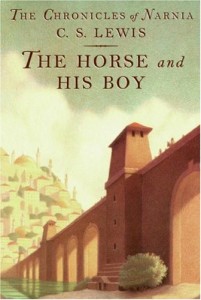 The Last Battle by C.S. Lewis
The Last Battle by C.S. Lewis
The Chronicles of Narnia # 7
Publisher: Scholastic
Number of pages: 224
My copy: paperback, bought from Scholastic Book Fair
The conclusion of the saga that began with The Magician’s Nephew.
NARNIA…where you must say good-bye…and where the adventure begin again.
The Unicorn says that humans are brought to Narnia when Narnia is stirred and upset. And Narnia is in trouble now: A false Aslan roams the land. Narnia’s only hope is that Eustace and Jill, old friends to Narnia, will be able to find the true Aslan and restore peace to the land. Their task is a difficult one because, as the Centaur says, “The stars never lie, but Men and Beasts do.” Who is the real Aslan and who is the imposter?
* * *
So right after reading The Magician’s Nephew, I jumped straight to the last book of The Chronicles of Narnia. Given the choice, I wouldn’t really have done that just yet — I tend to let the last book of any series linger a bit longer on my shelf, because I need a certain mindset before I say goodbye to any series I have loved, or at least, invested in. But I was on a little time pressure here — I was determined to read this book for Holy Week, and it just so happened that my reading The Last Battle was also on Good Friday.
Perfect timing, you think?
In The Last Battle, there is trouble in Narnia. As a reader, I was immediately introduced to this trouble, and I already know that the Aslan parading around Narnia is false one. I think C.S. Lewis did that on purpose instead of putting the readers in a state of the unknown like the other Narnians. For the first time since reading the series, I was really and truly scared for Narnia. How could they believe that this Aslan is the real one they know? How can they believe that so easily? How can they lose all that hope so easily, too? With all this trouble, Eustace and Jill came tumbling down Narnia, to help out and save them — but the question is, do they even want to be saved?
Like I said, it was the first time I was truly scared for the things happening in Narnia. I don’t know if this is investment in the series, or I was just…well, scared. Aslan is hands down one of my favorite characters, and possibly one of my favorite representations of God in literature, so seeing someone parade as a false one is scary. But in a way I can’t blame the people for acting that way. I’m not saying it’s right, but it just wasn’t surprising. Aslan being gone for a long time and with only his believers passing the belief down from generation to generation is bound to make some people question him at some point. I can’t help but think of how it is here in the real world — how people can just believe anyone and anything, and how, when disappointed by that, can make them not believe the one who should be believed in in the first place. It’s a messy, messy, thing. The Last Battle reminds me a bit of Prince Caspian, where the characters’ faith in Aslan was challenged so much that it was almost too late before they finally realized that they were wrong.
The Last Battle has a darker tone compared to the other books, and perhaps it also has the most bloodshed too. There were a bit too many battle scenes in this book that I can hardly think that this is a book for kids anymore. Reading The Magician’s Nephew before this was a good idea, I think, because there were a lot of details mentioned there that was mentioned in this book. The final scenes were a bit confusing but I liked how they brought all the characters back together.
I wasn’t planning to mention Susan in this review, but I guess I kind of have to. I think the Susan aspect is what makes The Last Battle a little dated. I mean, I understand what C.S. Lewis meant about it, and I guess it just so happened that Susan is that character who didn’t go the way the others chose to. It might not sit comfortably with other people, though, especially with how it was explained. I think readers should be careful to remember the time when this book was written to put the Susan thing in the proper context.
Nevertheless, I think The Last Battle was a pretty good ending for a beloved series, even if it is one that can spur new questions, not about the book but about what the author intends for it to represent in real life. If anything, I think The Last Battle is the Narnia book that dealt the most about faith and its nature, and how it is really a matter of choosing to stand up for what you believe and for who you believe in, even if everyone and everything else around you is saying otherwise.
So long, Narnia. It’s been a wonderful ride. One thing is for sure — wherever I go live in the future, there will always, always be a copy of the seven books of The Chronicles of Narnia. :)
But for them it was only the beginning of the real story. All their life in this world and all their adventures in Narnia had only been the cover and the title page: now at least they were beginning Chapter One of the Great Story which no one on earth has read: which goes on for ever: in which every chapter is better than the one before.
Rating: [rating=4]
Other reviews:
Dark Chest of Wonders
Reviews of other Narnia books:
#1 The Magician’s Nephew
#2 The Lion, the Witch and the Wardrobe
#3 The Horse and His Boy
#4 Prince Caspian
#5 Voyage of the Dawn Treader
#6 The Silver Chair




